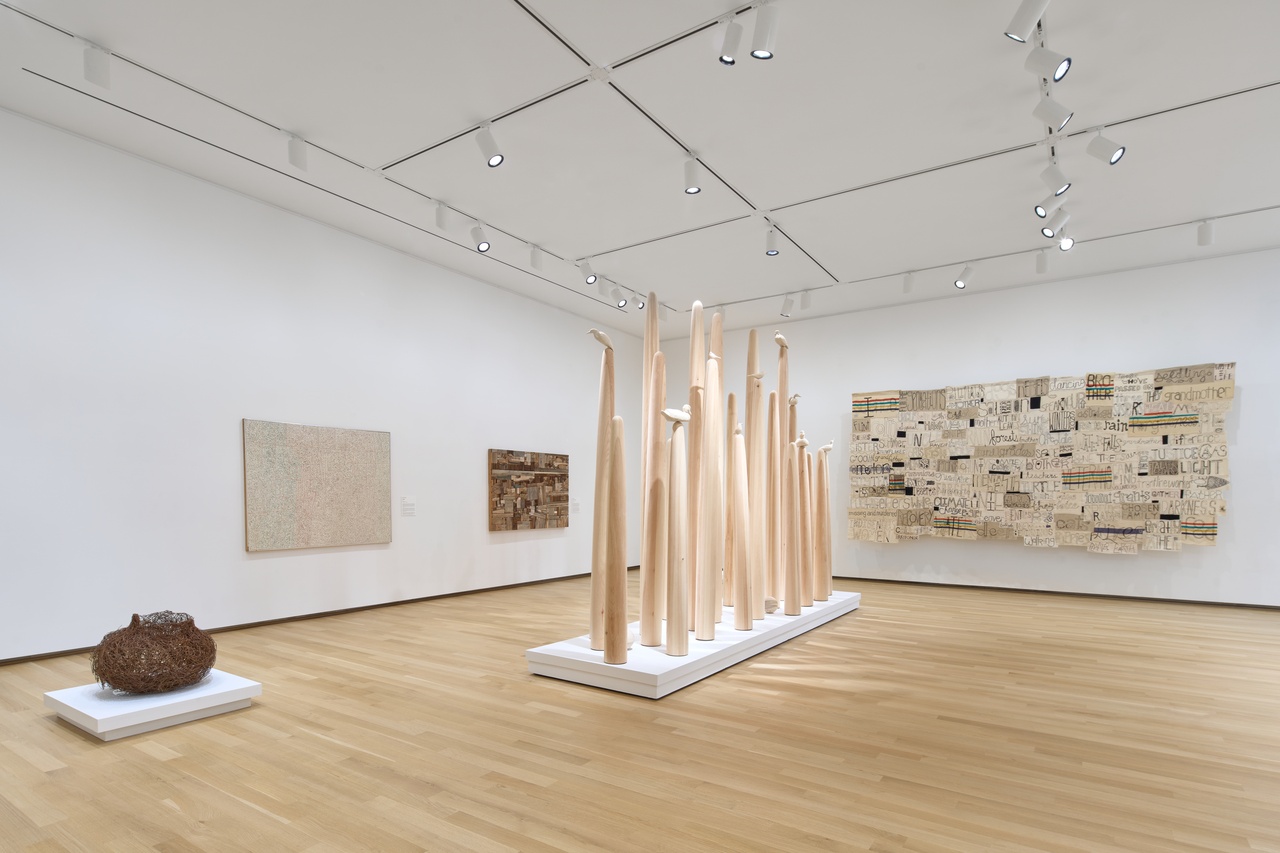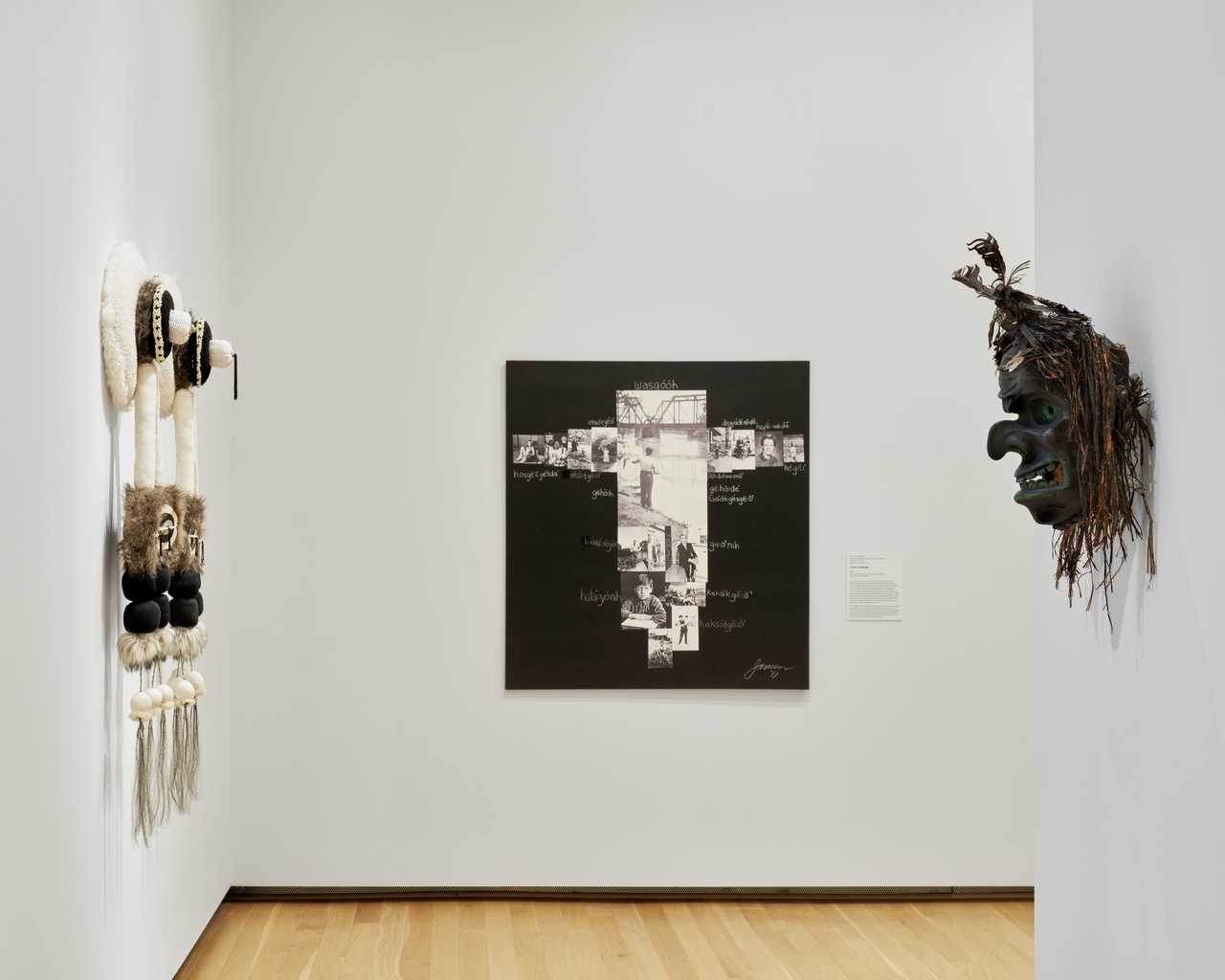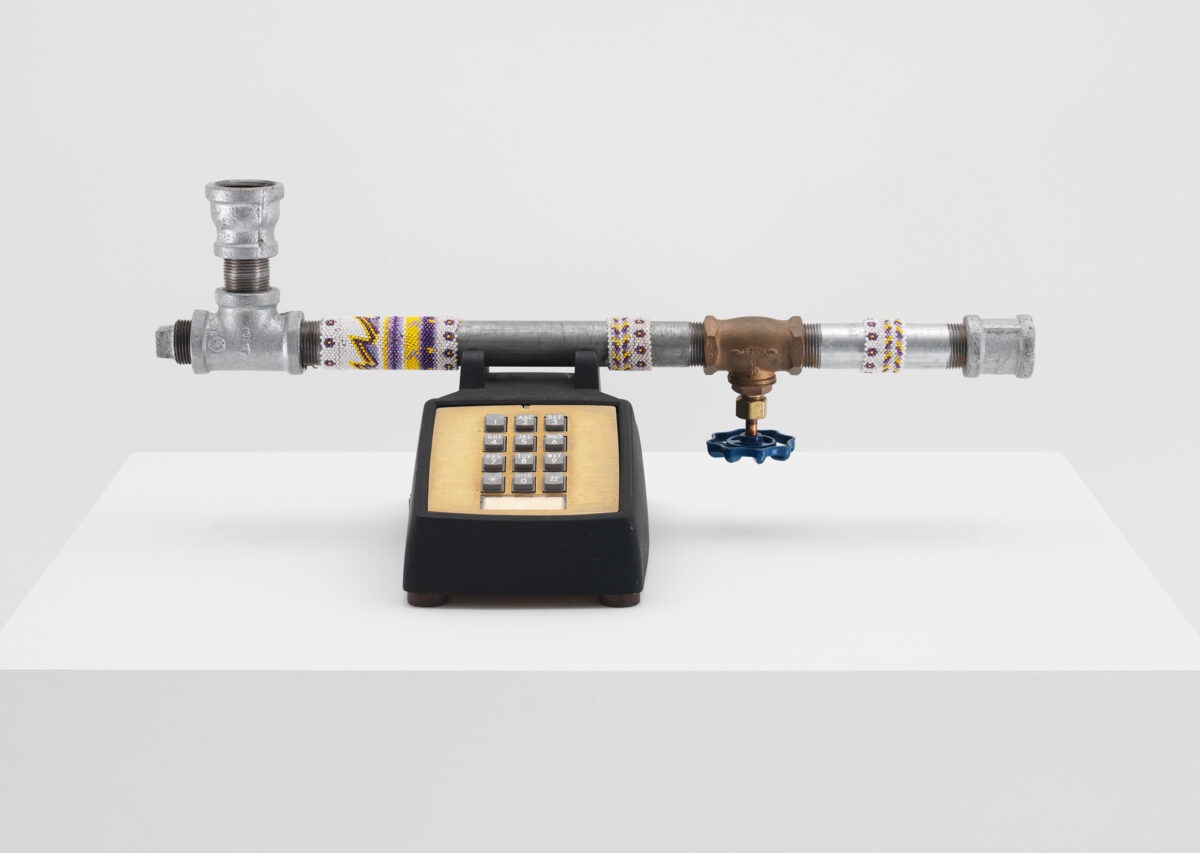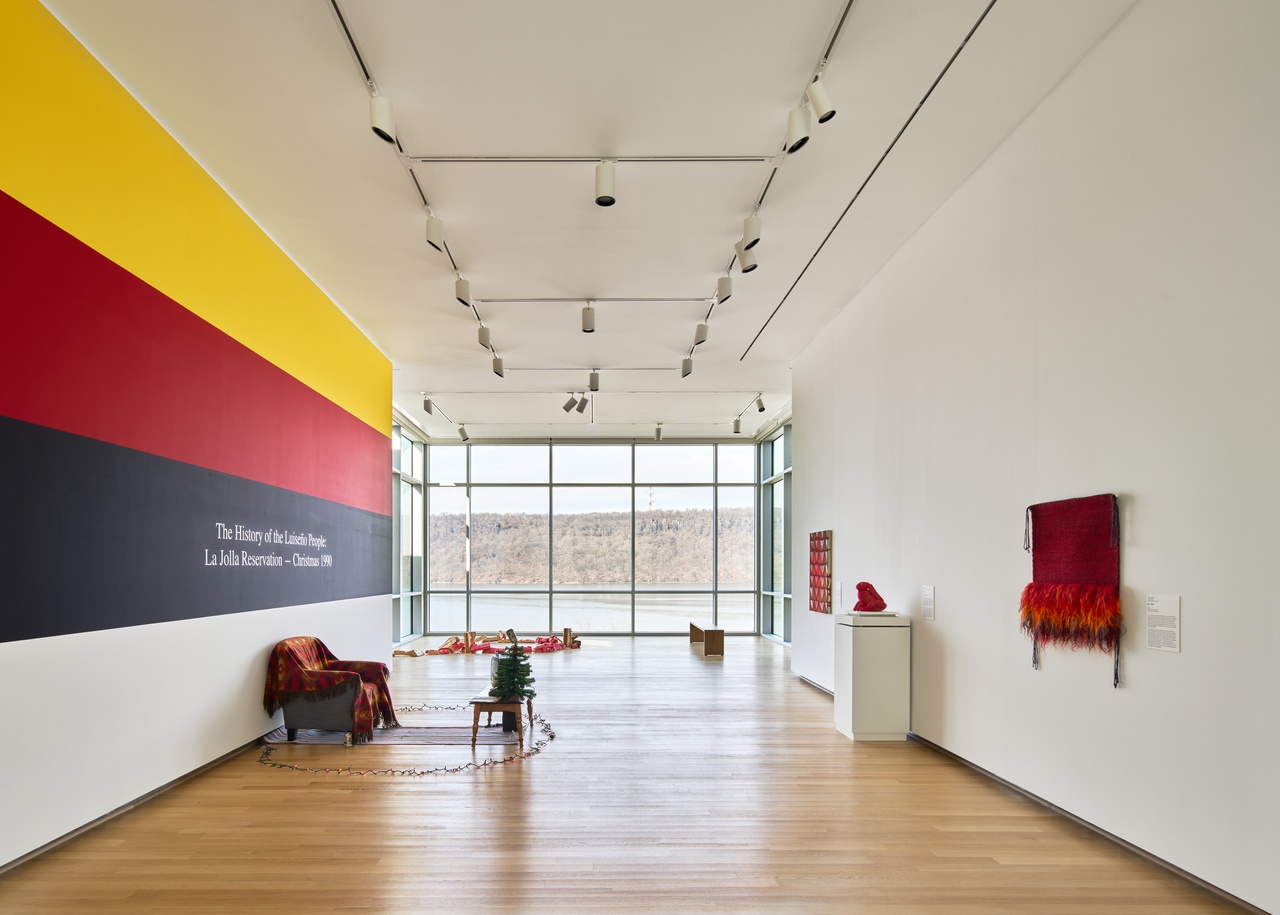LANDSCAPES OF MEMORY Mitchell Herrmann on “Smoke in Our Hair: Native Memory and Unsettled Time” at the Hudson River Museum, Yonkers, New York

“Smoke in Our Hair: Native Memory and Unsettled Time,” Hudson River Museum, Yonkers, New York, 2025
Man Mound, who resides in Wisconsin, has not been treated well. A road has been cut through his legs, leaving an asphalt scar that impedes his graceful gait. His feet have been given over to agriculture, a victim of the endless drive for “productive” land use so characteristic of settler economics. Nonetheless, Man Mound lives on – a physical manifestation of Indigenous resilience and resistance, a testament to memories that are shared between human and landscape in defiance of the myth of terra nullius, which imagined an empty continent free for the taking. And Man Mound’s gaze looks out to the future as well as to the past: “what appears lost,” explains a wall text in this exhibition, “can be remade, reimagined, or reclaimed.”
A human-shaped earthwork some 200 feet long, made a millennium ago by Late Woodland peoples, Man Mound served as inspiration for Never-Ending Monument (2021) by Andrea Carlson (Grand Portage Ojibwe), a sculptural centerpiece of one of the three galleries in “Smoke in Our Hair: Native Memory and Unsettled Time.” Composed of 27 wooden effigy staffs, atop which perch an eclectic flock of carved birds, Never-Ending Monument exemplifies the imbrication of temporal modes – “the nuanced layering of past, present, and future,” as a wall text puts it – that runs throughout the exhibition. Elegantly curated by Sháńdíín Brown (Diné) at the Hudson River Museum in Yonkers, New York, “Smoke in Our Hair” advances a compelling vision of Indigenous time that traverses the colonial scission between human and earth. Carlson’s practice, another wall text observes, “engages with landscape as a repository of memory and meaning.” Man Mound reminds us that the enduring knowledge and cultural practices of Turtle Island’s civilizations are written into its soil, alongside the defacement wrought by colonial violence. [1]
Laid out on a single floor in the Hudson River Museum’s new West Wing, the exhibition emphasizes generational connections that thwart simple binaries of historical and contemporary. Displayed on the wall behind Carlson’s sculpture are several works by the Ojibwe painter and sculptor George Morrison (1919–2000), known for his unique iteration of Abstract Expressionism. Morrison was a friend of Carlson’s father and influenced her practice. His understated but magnetic works – which here include a painting and a wall-mounted sculpture – are visible through the vertical poles of Carlson’s Never-Ending Monument, recalling the contours of Minnesotan lakeshores and horizon lines. Together, the works constitute a living ecology of artistic relation, echoing the landscapes that link generation upon generation of Native people.
Morrison’s work does not merely mimic landscape but draws directly from it – indeed, is constituted by it. One of his pieces within the exhibition, entitled Collage x Landscape, from 1975, is composed of numerous driftwood pieces from Lake Superior, arduously fitted together to form an intricate, rectangular surface. If one accepts the canonical interpretation of Abstract Expressionism as an exercise in medium specificity, an exploration of the intrinsic characteristics of paint on canvas, then Morrison widens the scope of such an investigation. His artistic materials include what some scholars have termed “elemental media,” the material matrices of meaning that extend beyond human artifacts and into the natural world. Yet Morrison’s use of such media – here, driftwood – calls upon Indigenous ideas that precede and anticipate the recent scholarly interest in the elements. More generally, Morrison’s art is a welcome counterpoint to the quasi-primitivist inclinations of so many of his white peers in the Abstract Expressionist movement, whose intense fascination with Indigenous culture often did not escape the tropes of colonial ethnography.

“Smoke in Our Hair: Native Memory and Unsettled Time,” Hudson River Museum, Yonkers, New York, 2025
The profound significance that may be found in natural materialities is an organizing principle of this exhibition: Morrison’s and Carlson’s works are part of the “wood” section, which is joined by galleries organized around “fire” and then “smoke.” Each gallery features a gamut of formats and scales, from interactive installation to photographic portraiture to tobacco-scented sculpture (the latter is Métis artist Gabrielle L’Hirondelle Hill’s X-tend from 2021 – a reference to the complicated history of tobacco both within and beyond its colonial commodification). Every work is given room to breathe by Brown’s careful curation and finds a conceptual connection to its formally eclectic neighbors through the theme of wood, fire, or smoke – which are reflected in the art both literally (as in the wooden art of Morrison and Carlson) and in more abstract ways. All three elements appear in the writing of Ofelia Zepeda (Tohono O’odham), whose poem “Smoke in Our Hair” lends the exhibition its title. “Smoke, like memories, permeates our hair, / our clothing, our layers of skin,” Zepeda writes. [2] Memory resides in bodies both human and earthly, kept alive in the bond between people and land.
Wood, fire, and smoke form a circle of transformation and rebirth, a model of “cyclical and relational” temporality disallowed by the Euro-American emphasis on strict chronologies and progressive development. Nonlinear time allows for the “deployment of tradition as strategic cultural resistance,” in the words of Indigenous scholar Jolene Rickard – a tactic seen throughout the exhibition. [3] The textile collage Companion Species (Remembering Song) (2021) was produced out of group sewing circles with artist Marie Watt (Seneca and German-Scot) and numerous collaborators. Dozens of words embroidered into the cloth reflect the memory of past and present traumas (“missing and murdered Indigenous women”) interwoven with hopes for an ecologically sustainable world to come (“spring rains” and “future generations”). Eric-Paul Riege, a Diné artist whose woven jewelry for “giant gods” was also a highlight of Candice Hopkins’s landmark “Indian Theater” exhibition at Bard’s Hessel Museum of Art in 2023, likewise exemplifies an emphatically living tradition of Indigenous artistic technique. [4]

James Luna, “Hi-Tech Peace Pipe,” 1992
The interest of “Smoke in Our Hair” in Indigenous Futurism is playfully embodied by James Luna’s Hi-Tech Peace Pipe (1992), placed strategically near the exhibition’s entrance. Here, a plumbing pipe of steel and brass has been attached to a vintage telephone base and adorned with bands of colored beads – a bricolage version of the pipes that form part of many Native cultures. “The metal pipe represented a by-product of having to make do with having diminished our supply of pipestone,” the artist explains in the wall text. “We have been able to survive by making do with what we have been given or in some cases, with what we have left to us.” Luna (Payómkawichum, Ipai, and Mexican), who passed away in 2018 and was among the most influential figures in contemporary Indigenous art, joined the sharp edge of his political critique – aimed at reductive stereotypes and racist institutions – with a spirit of generous humor.
Luna’s Hi-Tech Peace Pipe is accompanied by another of the artist’s works in a different gallery: The History of the Luiseño People: La Jolla Reservation, Christmas, from 1990, an installation whose mock-ethnographic title is deflated by the bathos of beer cans and a plastic Christmas tree set in front of a lonely armchair. It is a scene of isolation and possible penury, taken from the artist’s own turbulent life – a moment of raw realism that shatters colonial fantasies of Native people as inhabitants of a mythic but vanished past, rather than as survivors coping creatively with the challenges of a world structured against them. It is from within this world, with all its banal but relentless obstacles, that Luna builds another: His Hi-Tech Peace Pipe is a fragment of an Indigenous future, built from assembled shards of the present. Luna’s futurism is far from the standard sci-fi drama of interstellar colonization, where a whitewashed parody of European conquest would be played out in space amid the polished décor of corporate technology. Rather, it is a vision both more modest and more ambitious – of making do in the ruins of modernity’s long and violent history, in the aftermath of an apocalypse which, for so many colonized peoples, has already occurred many times over.

“Smoke in Our Hair: Native Memory and Unsettled Time,” Hudson River Museum, Yonkers, New York, 2025
Indigenous scholar Kim TallBear has written on the particular qualities of pipestone, the material Luna references in his sculpture. For some Native communities such as the Dakota people, TallBear explains, there is “life that inheres in a particular stone, and … social relations that proliferate as that stone emerges from the earth, is carved into pipe, and is passed from hand to hand.” [5] In light of this animacy, Luna’s metal sculpture appears not only as a marker of resilience and invention but also as a kind of memorial for a part of nature nearly destroyed by colonial depredation. This points to a broader implication of the art in this exhibition, much of which bears upon pressing environmental questions precisely by exceeding the standard frame of discourse on the topic. Environmental protectionism tends to imagine landscape as a passive vessel for human action – whether benevolent or destructive – thereby assuming a simplistic dichotomy that accords the natural world neither agency nor independent moral worth.
The Indigenous relations to pipestone described by TallBear rest on a far richer understanding of human embeddedness in the natural world, as do the many artworks in this exhibition that foreground the entanglement of memory and place. Man Mound, the earthen figure that inspired Andrea Carlson’s Never-Ending Monument, is not an artwork merely inserted into the blank canvas of landscape, like so many Land Art earthworks by white artists in the 20th century. Carlson’s art, with its recollection of Indigenous culture constituted in and with the soil, emphasizes that North American landscapes are never neutral. They are composed of histories of both care and exploitation, of Native memory set against colonial forgetting. In a moment when this memory is under renewed threat by the forces of political reaction, “Smoke in Our Hair” offers a reminder of the Indigenous strategies that have resisted colonial erasure for centuries. A better future, this artwork tells us, may yet emerge from the palimpsest of violence that is Turtle Island.
“Smoke in Our Hair: Native Memory and Unsettled Time,” Hudson River Museum, Yonkers, New York, February 14–August 31, 2025.
Mitchell Herrmann is a PhD candidate in modern and contemporary art history at Yale University.
Image credits: 1.- 2. Courtesy Hudson River Museum, photos Steven Paneccasio; 3. Courtesy Gochman Family Collection; 4. Courtesy Hudson River Museum, photo Steven Paneccasio
Notes
| [1] | Turtle Island is a name used by some northeastern Native American peoples to refer to North America. It has since been adopted more widely as a name of non-European origin for the continent. |
| [2] | Ofelia Zepeda, “Smoke in Our Hair,” in Where Clouds Are Formed (University of Arizona Press, 2008). Available online at the Poetry Foundation website. |
| [3] | Jolene Rickard, “Visualizing Sovereignty in the Time of Biometric Sensors,” South Atlantic Quarterly 110, no. 2 (2011): 474. |
| [4] | Eric-Paul Riege, “I Am the Warp, You Are the Weft: An Interview with Eric-Paul Riege”, by Paul Schmelzer, Bockley Gallery, March 23, 2023. |
| [5] | Kim TallBear, “Beyond the Life/Not-Life Binary: A Feminist-Indigenous Reading of Cryopreservation, Interspecies Thinking, and the New Materialisms,” in Cryopolitics: Frozen Life in a Melting World, ed. Joanna Radin and Emma Kowal (MIT Press, 2017), 195. |

